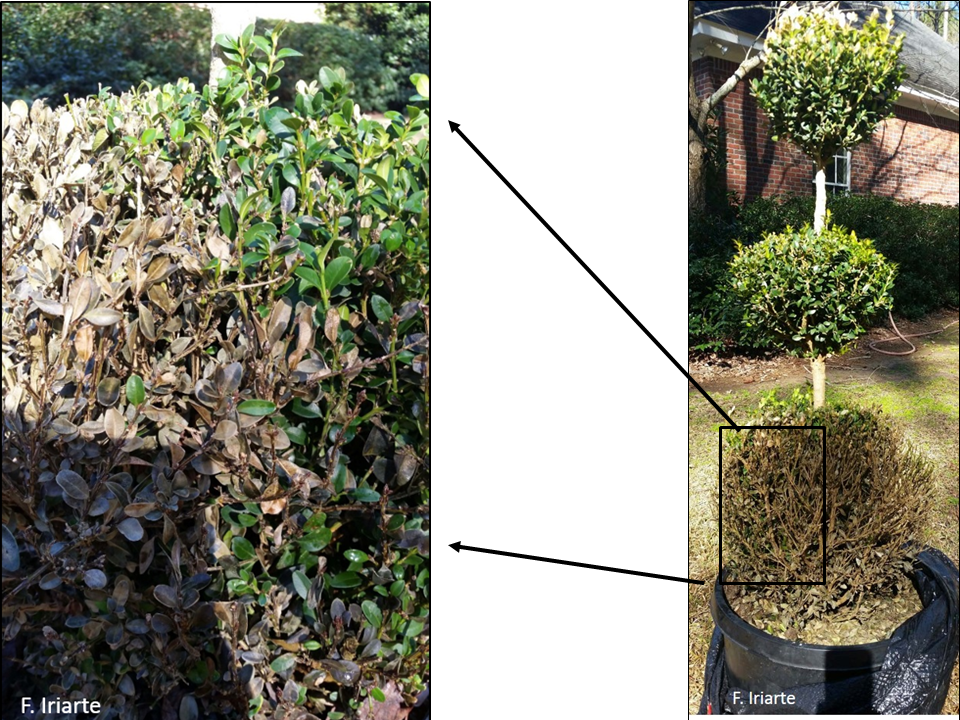
Close up of Boxwood Blight symptoms from the pyramid boxwood to the right. Note the dark discoloration of the leaves. Stems presented same dark discoloration. Also note leaf drop on the soil inside the pot. Photo credit: Fanny Iriate
Fanny Iriarte, Mathews Paret, and Gary Knox, University of Florida, North Florida Research and Education Center, Quincy
In April 2015, Boxwood Blight was confirmed in a commercial nursery in North Florida (Pest Alert: Boxwood Blight) In February 2016, the disease was confirmed in the Florida Panhandle at a nursery and in a residential landscape in Leon County.
- The Boxwood blight pathogen has been confirmed by the University of Florida NFREC Plant Diagnostic Clinic and the Division of Plant Industry, FDACS in a residential landscape in Tallahassee (early February 2016). In this case, a pyramid boxwood showing symptoms (photo above) had been purchased from a nursery in Georgia; in turn, the Georgia nursery had purchased the plant from Oregon. The plant was asymptomatic at the time of purchase and transport to Tallahassee. The pathogen started causing symptoms of disease in early January when environmental conditions were conducive for disease development (cool and wet).
- A second finding of the disease was confirmed by Division of Plant Industry at a local nursery in Leon county (late February 2016). In this case, the plants came from Mississippi.
- DPI, the property owner in the first case, and the nursery personnel in the second case are currently implementing strategies to eradicate the disease from the locations to avoid any further spread.
Recommendations for landscapers
- Inspect boxwoods on your property for leaf spots and blight symptoms.
- Keep in mind that besides infected plant material and plant debris, fungal spores can also be moved by water, wind, shoes, tires, clothing or animal fur. Disease can be also spread by pruning tools, shovels, hoses or any other landscape equipment from infected to healthy plants in the same property or to other properties.
- Train employees and clients on how to identify Boxwood blight and how to avoid disease spread.
- Whenever possible, purchase plants from nurseries that have a Boxwood Blight Compliance Agreement through their State Department of Agriculture (e.g.: Georgia Department of Agriculture).
- Disinfect pruners, other tools, or shoes within and between different blocks of plants within the same landscape and specially when moving to other landscapes. Good products are Lysol Concentrate Disinfectant (2.5 Tbsp/gallon of water) or a 10 % bleach solution.
- Submit samples for confirmation of disease: PLANT DISEASE DIAGNOSTIC LAB SAMPLE SUBMISSION FORM
For more information on Boxwood Blight:
Pest Alert: Boxwood Blight (original Panhandle Ag News Article)
Nursery Industry Voluntary Best Management Practices for Boxwood Blight
www.boxwoodblight.org
North Carolina State Ornamental Plant Pathology
Latest posts by Fanny Iriarte (see all)
- Citrus Greening (HLB) Update for North Florida and Georgia - December 17, 2021
- Hemp Diseases in North Florida - March 19, 2021
- NFREC Plant Disease Diagnostic Clinic in Quincy Reopens with Limited Hours - April 17, 2020
